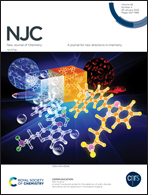A new “on–off–on” g-C3N4 nanosheets fluorescent sensor for 5-Br-PADAP and Co2+ under acidic conditions†
Abstract
Scientists are still working on developing a “turn-on” fluorescence sensor for Co2+, especially in acidic solutions. A novel “on–off–on” fluorescence sensor based on g-C3N4 nanosheets was designed and prepared in this paper. It was able to detect (2-(5-bromo-2-pyridylazo)-5(diethylamino)phenol (abbreviated to 5-Br-PADAP) and Co2+ quantitatively by quenching and restoring the fluorescence of the g-C3N4 nanosheet system, respectively. Also discussed are the effects of solvent, pH, order of addition, and interaction time of 5-Br-PADAP and Co2+, as well as the concentration range of the object on measurement. Furthermore, in acidic conditions, the sensor demonstrated good selectivity and sensitivity. In the solvent system EtOH : H2O (v/v = 1 : 9, pH = 3), the fluorescence intensity had a good linear relationship with 5-Br-PADAP and Co2+ concentrations in the ranges of 0–15 μM and 0–10 μM, with low detection limits of 64 nM and 44 nM, respectively. Experiments and theoretical calculations were used to describe the interaction characteristics and sensing mechanism. It was eventually successful in detecting Co2+ in environmental samples.



 Please wait while we load your content...
Please wait while we load your content...